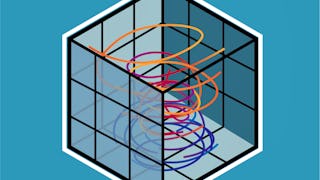In this course each student will create a scientific animation that tells a story with data to better communicate scientific results – along the way they will learn programming, science writing, and technical animation skills.



Data-Driven Animation for Science Communication

Instructor: Dr. Jessica Kendall-Bar
4,930 already enrolled
Included with 
(14 reviews)
What you'll learn
Learners will be able to replicate the data-driven animation process from conceptualization to asset creation, data visualization, and composition.
Learners will be able to make informed decisions between available programs and techniques for visualizing data.
Learners will be able to distill the methods, results, and implications of scientific research into an accessible, succinct, and impactful animation.
Skills you'll gain
- Data Presentation
- Video Editing
- Style Guides
- Data Storytelling
- Adobe Premiere
- Professional Development
- Data Literacy
- Computer Graphic Techniques
- Post-Production
- Scientific Visualization
- Autodesk Maya
- Adobe After Effects
- Peer Review
- Technical Communication
- Graphics Software
- Animations
- Visualization (Computer Graphics)
- Data Visualization Software
- Storyboarding
- Motion Graphics
Details to know

Add to your LinkedIn profile
See how employees at top companies are mastering in-demand skills

There are 5 modules in this course
In this Module you will lay out the groundwork for your data-driven animation. You will pick a scientific study, tell its story, interpret a dataset, and compose a style guide that determines the fonts, colors, and mood of your animation. Using your script and style guide, you will plan out the action for each scene in your animation. After that, you will create a storyboard conveying the major action in your animation and, from that storyboard, create an animatic.
What's included
16 videos17 readings3 assignments1 peer review2 discussion prompts
In this Module you will use the animatic and list of assets from the last session to decide which custom assets to create. You will learn digital illustration techniques in Adobe Illustrator and Adobe Photoshop to create these assets with specific attention paid to the future ability to animate the assets. We will create data visualizations, learning about different tools, programs, and guiding principles.
What's included
26 videos2 readings2 assignments2 discussion prompts
In this Module you will develop one of the scenes from your animatic into an animated scene that incorporates motion graphic principles. You will learn how to animate text, lines, and shapes in Adobe After Effects. You will also create an animated version of your improved key figure. We will learn to use JavaScript programming within Adobe After Effects to link data to the attributes of an animated 2D scene.
What's included
21 videos4 readings3 assignments2 discussion prompts
In this Module you will familiarize yourself with the interface of a 3D animation software, Autodesk Maya. You will use your own custom 3D model or a demo file to animate a locomotion cycle (walk, swim, fly, etc., depending on your organism). You will learn about the major steps of creating a 3D animation from modeling and rigging to animation and rendering. You will use the locomotion cycle to create a data-driven animation. We will learn how to use Python programming in Autodesk Maya to create data-driven 3D scenes.
What's included
17 videos4 readings1 assignment2 discussion prompts
In this Module you will assemble the animated scenes you have generated into a fully produced animation. You will learn the basics of editing and composition using an Adobe workflow between Adobe Premiere Pro and Adobe After Effects. We will learn about the importance and power of musical accompaniment in creating your final composition. You will critique each other’s final projects in a peer reviewed assignment.
What's included
10 videos3 readings2 assignments1 peer review1 discussion prompt
Instructor

Offered by
Explore more from Data Analysis
 Status: Preview
Status: PreviewUniversity of Illinois Urbana-Champaign
 Status: Free Trial
Status: Free TrialUniversity of Colorado Boulder
 Status: Preview
Status: PreviewUniversity of Colorado Boulder
 Status: Preview
Status: PreviewIllinois Tech
Why people choose Coursera for their career




Learner reviews
14 reviews
- 5 stars
78.57%
- 4 stars
14.28%
- 3 stars
7.14%
- 2 stars
0%
- 1 star
0%
Showing 3 of 14
Reviewed on Nov 20, 2024
Amazing Course to cover all things in animation field

Open new doors with Coursera Plus
Unlimited access to 10,000+ world-class courses, hands-on projects, and job-ready certificate programs - all included in your subscription
Advance your career with an online degree
Earn a degree from world-class universities - 100% online
Join over 3,400 global companies that choose Coursera for Business
Upskill your employees to excel in the digital economy
Frequently asked questions
To access the course materials, assignments and to earn a Certificate, you will need to purchase the Certificate experience when you enroll in a course. You can try a Free Trial instead, or apply for Financial Aid. The course may offer 'Full Course, No Certificate' instead. This option lets you see all course materials, submit required assessments, and get a final grade. This also means that you will not be able to purchase a Certificate experience.
When you purchase a Certificate you get access to all course materials, including graded assignments. Upon completing the course, your electronic Certificate will be added to your Accomplishments page - from there, you can print your Certificate or add it to your LinkedIn profile.
Yes. In select learning programs, you can apply for financial aid or a scholarship if you can’t afford the enrollment fee. If fin aid or scholarship is available for your learning program selection, you’ll find a link to apply on the description page.
More questions
Financial aid available,
¹ Some assignments in this course are AI-graded. For these assignments, your data will be used in accordance with Coursera's Privacy Notice.

